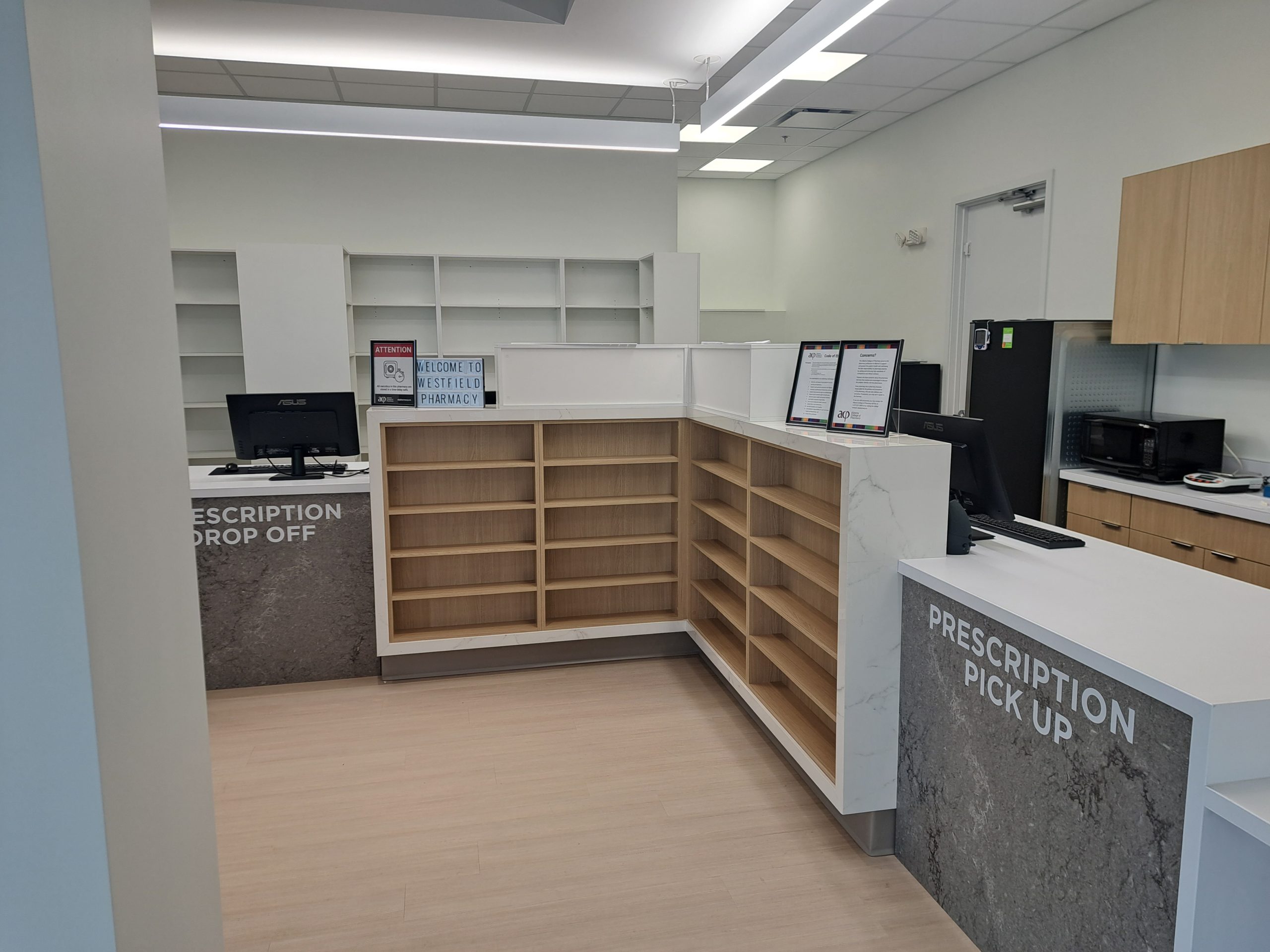Chapelle Pharmacy
Constructing a pharmacy involves careful planning and precise execution to create a space that is both functional and inviting, ensuring it meets regulatory standards and provides excellent customer service. Here’s a detailed overview of the process:
Initial Phase: Conceptualization and Planning
- Needs Assessment: The project began with consultations with pharmacists, stakeholders, and designers to understand the specific requirements. The goal was to create a practical, efficient layout that promotes easy navigation and quick access to pharmaceutical services.
- Site Selection and Evaluation: A suitable location was chosen, ideally in a high-traffic area with easy access for customers. A thorough site evaluation was conducted to assess structural requirements and potential challenges.
Phase 1: Design and Architectural Planning
- Architectural Design: Detailed blueprints and 3D models were developed, focusing on optimizing space for retail, prescription processing, and consultation areas. The design included clear pathways, designated areas for over-the-counter medications, and private consultation rooms.
- Material Selection: High-quality, durable materials were selected for flooring, walls, and fixtures. Choices included hygienic and easy-to-clean surfaces to maintain a clean environment.
- Lighting Design: A comprehensive lighting plan was developed, focusing on bright, even lighting to ensure visibility and create a welcoming atmosphere. LED lights were chosen for their efficiency and longevity.
Phase 2: Construction and Build-Out
- Structural Work: Initial construction involved any necessary structural changes, such as reinforcing floors and ceilings, and making adjustments to the layout. This phase ensured the building could support the new design and meet safety standards.
- Interior Build-Out: The interior construction phase included installing flooring, wall treatments, and custom-built shelving units. Special attention was given to creating ergonomic and functional spaces for both customers and staff.
- Technology Integration: Modern pharmacy technologies were integrated into the design. This included electronic prescription systems, secure data storage, and automated dispensing machines to enhance efficiency and accuracy.
Phase 3: Specialized Areas and Equipment
- Dispensing Area: The dispensing area was designed to be efficient and secure, with ample counter space, storage for medications, and secure access for pharmacists.
- Consultation Rooms: Private consultation rooms were constructed to provide a comfortable and confidential space for patient consultations and health services, such as vaccinations and health checks.
- Retail Area: The retail area was laid out to promote easy navigation and visibility of over-the-counter medications, health products, and wellness items. Display units were designed to be accessible and attractive.
Phase 4: Finishing Touches and Detailing
- Custom Fixtures and Furnishings: Custom fixtures were installed, including counters, shelving units, and display cases. Each piece was chosen for its functionality and contribution to a cohesive design.
- Decor and Signage: Branding elements, signage, and decor were added to create a professional and welcoming atmosphere. This included clear directional signs, informational posters, and decorative elements that reflect the pharmacy’s identity.
- Exterior Design: The exterior of the pharmacy was designed to be inviting and reflective of the high-quality services provided inside. This included attractive signage, clean window displays, and a well-maintained entrance area.
Phase 5: Quality Assurance and Finalization
- Inspection and Quality Control: Rigorous inspections were conducted to ensure all construction and design elements met safety, regulatory, and quality standards. Any necessary adjustments were made promptly.
- Staff Training and Soft Opening: Before the official opening, staff were trained on the pharmacy’s layout, technology, and customer service standards. A soft opening was held to test operations and make any final adjustments.
Completion and Grand Opening
- Grand Opening Event: The project culminated in a grand opening event, attended by key stakeholders, community members, and potential customers. The event showcased the pharmacy’s modern design, comprehensive services, and customer-friendly layout.
- Customer Experience: The completed pharmacy offered a modern, efficient, and welcoming environment for health and wellness. The thoughtful design and advanced technology ensured a positive experience for customers and staff alike.
The construction of the pharmacy was a successful project, resulting in a state-of-the-art facility that provides high-quality pharmaceutical services. The modern design, advanced technology, and focus on customer care set it apart as a leading health hub in the community.

